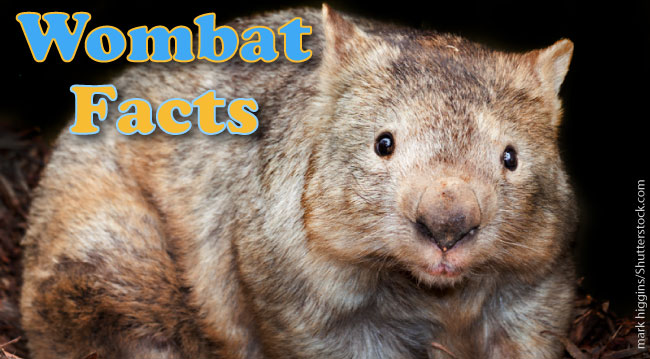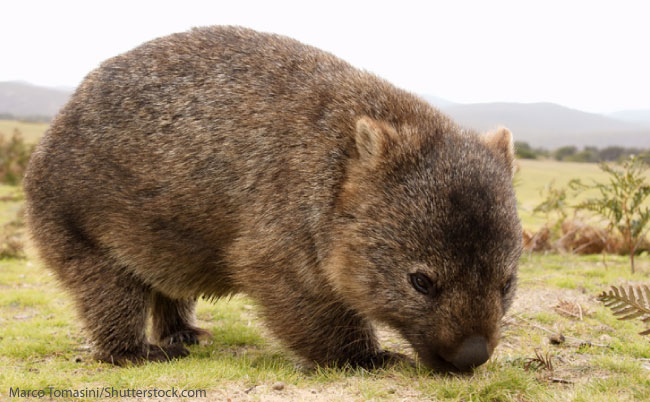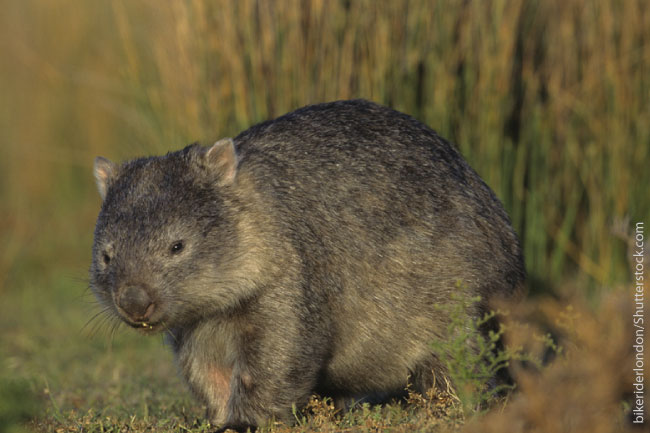Wombats are Australian marsupials. They are burrowing creatures and are most active at night. This page contains wombat facts, and is part of our Australian Animals series. Read on to find out more about these interesting animals…
Wombat Facts
Wombats are sturdy, burrowing marsupials that are found only in Australia.
Three Species
There are three species of wombat: the Bare-nosed, or Common wombat (Vombatus ursinus); the Northern hairy-nosed wombat (Lasiorhinus krefftii); and the Southern hairy-nosed wombat (Lasiorhinus latifrons).
Wombats live in large, complex tunnel-and-chamber burrows which they excavate with their powerful claws and rodent-like front teeth.
Common wombats are usually solitary and live in their own burrows, however, the other species are more social and live together in larger burrow groups.
What Does A Wombat Look Like?
All three species are approximately 36 in (100 cm) long, 20 in high and weigh between 44 and 77 lbs (20 and 35 kg). They have short legs, a thick, muscular body with a large square head, short neck, round ears and very small eyes. Their hind-legs are longer than their fore-legs.
In body shape, wombats resemble badgers or small bears. Wombat fur can vary from gray to black or a sandy colour. The tail is short and stubby.
Backwards-facing Pouch
Being marsupials, wombats have a pouch for rearing their offspring. One distinctive characteristic of wombats is that their pouch opens backwards. This prevents soil collecting in the pouch; especially important when the female is carrying young.
Wombats are usually slow movers. However, if threatened, they can sprint up to 25 mph (40 km/h) for brief periods of around 90 seconds.
Wombat Video
You can see what a wombat looks like in the video below:
Wombat Facts: Diet and Feeding
Wombats are herbivores and nocturnal. They emerge from their burrows to eat mostly grasses, roots, herbs and bark. Their incisor teeth resemble those of rodents and grow constantly as they are adapted for gnawing on tough vegetation.
The front paws of the Bare-nosed wombat are quite nimble-fingered and they can use them like hands to grasp vegetation, tear it up, and pass it to their mouth. Hairy-nosed wombats do not have this dexterity and cannot make a fist with their hand. This difference means that Bare-nosed wombats can climb trees whereas Hairy-nosed wombats cannot.
Wombats have a very slow metabolism which is an adaptation to help their survival in arid conditions. It takes around 8 to 14 days for them to complete digestion. Wombats have cube-shaped feces which they use to mark their territories; it’s thought that the unusual shape of the feces prevents them from rolling away.
Defense
The main predators of wombats are Tasmanian devils and dingoes. Wombats initially avoid being caught by having a very tough rear hide, with most of the rump made of cartilage. This prevents teeth or claws from easily grasping the wombat. Their very short tail also makes it difficult for a predator to catch them. Wombats try to drive off attackers with two-legged kicks, like a donkey or horse. If chased, wombats dive into a nearby tunnel and use their hardened rump to block the attacker. In some cases, wombats allow the attacker to force their head over the wombat's back, and then use their powerful legs to crush the skull of the attacker against the tunnel roof.
Reproduction
Female wombats have a brief gestation period of only 20 to 21 days, after which they give birth to a single, tiny, undeveloped young, usually in the spring. The youngster immediately crawls through the fur to the pouch on their mothers' bellies and attaches to one of the 2 nipples inside. The young leaves the pouch after about 6 to 7 months, but will still frequently climb back into the pouch to suckle or when threatened. The mother weans the youngster at about 15 months. Wombats become sexually mature at about 18 months of age and can live for 5 to over 30 years.
Are Wombats Endangered?
The Northern hairy-nosed wombat is endangered due to several threats including its small population size, predation by wild dogs, competition for food with livestock and disease. They inhabit only two places one of which is home to only 138 of this species according to the latest study. The common wombat is still hunted as vermin.
Quick Wombat Facts For Kids
- A group of wombats is called a “wisdom”.
- A wombat can move up to 3 feet (1 metre) of dirt in a single day when building a burrow.
- There are reports of human injuries from wombat attacks, including injuries from being bowled over by charging wombats.
- Wombats have special bones in their backsides which allow them to squeeze and form their feces into cubes.
- During the Ice Age, there used to be giant wombats the size of a rhinoceros.
- Wombats live in large complex burrows up to 100 ft (30 m) long.
- Wombats are the largest burrowing animal in the world.
- Wombats have the most developed brain of any marsupial.
- The bones and musculature around the jaw are very much like the beaver – but they are not related.
- Although generally quiet, if wombats become angry, they make hissing sounds.
Wombat Facts Conclusion
We hope that you have enjoyed these wombat facts. Australia is home to many other incredible creatures: find out about more of them here: Australian Animals.




